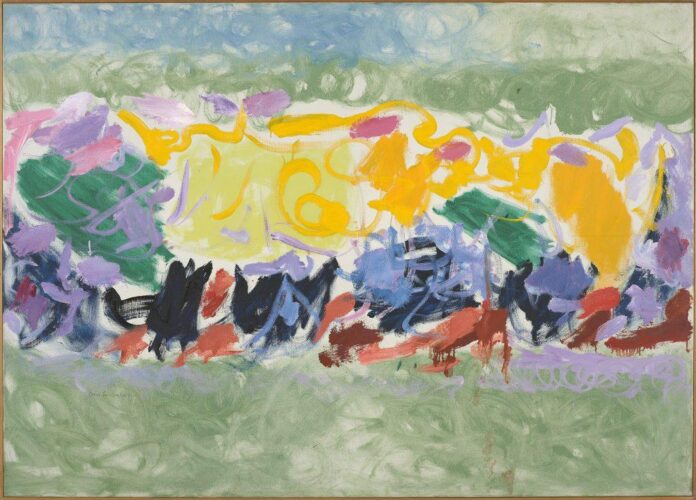About the Artist: A native New Yorker, Ethel Schwabacher (1903–1984) spent much of her career steeped in the vibrant and dynamic art scene of the city, and she is today recognized as an important and influential member of the Abstract Expressionist movement. While current art historical scholarship frequently investigates the work of women artists who have been overlooked, Schwabacher is significant in that she was quite well-known in her time. She was represented by the famed Betty Parsons Gallery, a hub of avant-garde art in the 1940s and ’50s, and moved in the same circles as artists like Willem de Kooning, Kenzo Okada, and José Guerrero. Arshile Gorky, an artist credited as a seminal influence on Abstract Expressionism, was a close friend and mentor of Schwabacher, and she ultimately wrote and published Gorky’s biography in 1957. Gorky introduced Schwabacher to automatism in the 1930s, a mode of artmaking that emphasizes the subconscious mind, which in conjunction with prevailing abstract trends in the art world, led the artist to develop her own distinct and inimitable artistic style. Her work is held in numerous important collections today, including the Metropolitan Museum of Art, New York; San Francisco Museum of Modern Art, California; and Smithsonian American Art Museum, Washington, D.C., among others.

Ethel Schwabacher (ca. 1920s). Courtesy of Berry Campbell, New York.
What You Need to Know: On view through May 26, 2023, Berry Campbell in New York presents “Ethel Schwabacher: Woman in Nature (Paintings from the 1950s),” the gallery’s first show on Schwabacher—and the artist’s first solo show in New York in 30 years. Berry Campbell has developed a specialty in significant women artists from the 1950s, and Schwabacher is a fitting addition to the gallery’s roster. Many of the works on view have not been exhibited since they were included in one of the artist’s five solo shows with Betty Parsons Gallery, counting the present exhibition’s large-scale cornerstone (1959). Accompanied by a 26-page exhibition catalogue containing an essay by Dr. Joan M. Marter, the exhibition offers an exciting opportunity to see one of Abstract Expressionism’s more prominent woman artists.

Ethel Schwabacher (ca. 1955). Courtesy of Berry Campbell, New York.
Why We Like It: Schwabacher’s vivid and gestural compositions within the exhibition at Berry Campbell illustrate the confluence of influences and inspirations she employed. While each painting contains its own inherent logic and balance, the unencumbered brushstrokes and free use of color convey a sense of immediacy and vigor. Works such as (1955) offers a tantalizing glimpse into her world and vision, evoking the sense of a landscape or window view filtered through her own finely honed abstract style—and evidencing the continued influence of automatism. Later in the decade, (1958) eschews any hint of the representational, and embodies total abstraction. Though Schwabacher established a presence and career for herself in her lifetime, her oeuvre has still not garnered the same academic or critical attention as her male counterparts. This exhibition presents the opportunity not only to bring Schwabacher’s work back to the spotlight, but also initiate a renewed interest in her work within the art world at large.
See featured works from the exhibition below.

Ethel Schwabacher, (1955). Courtesy of Berry Campbell, New York.

Ethel Schwabacher, (1957). Courtesy of Berry Campbell, New York.

Ethel Schwabacher, (1957). Courtesy of Berry Campbell, New York.

Ethel Schwabacher, (1958). Courtesy Berry Campbell, New York.

Ethel Schwabacher, (1959). Courtesy of Berry Campbell, New York.

























